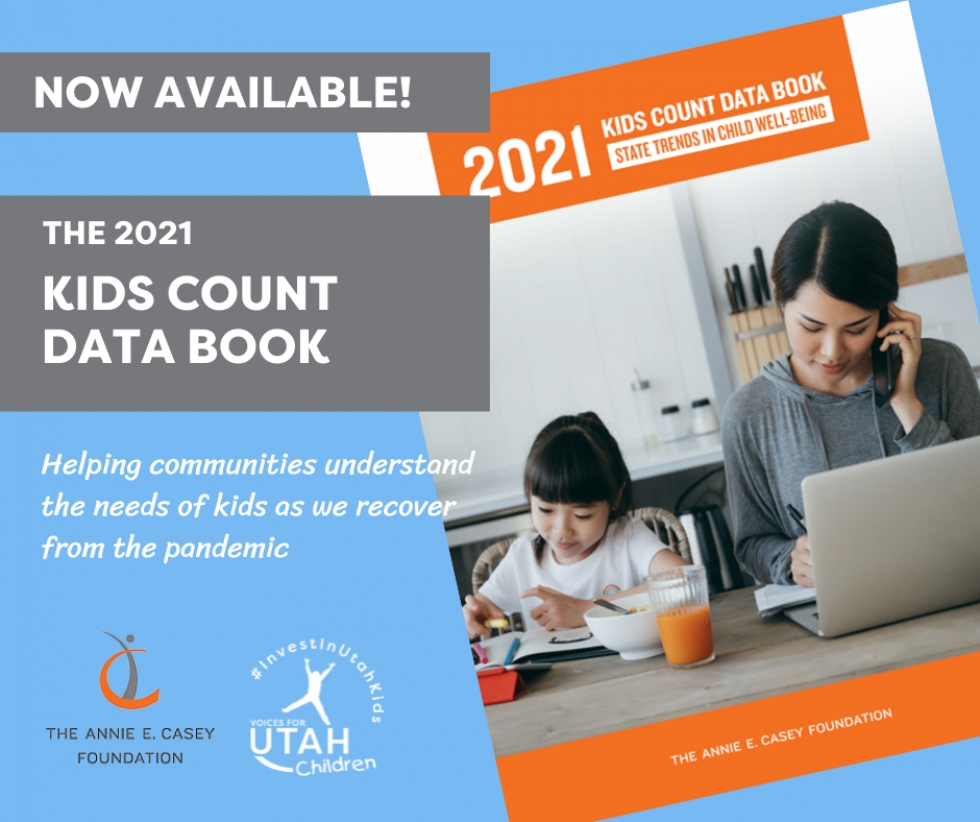We are pleased to announce that the Annie E. Casey Foundation has released the 2021 Kids Count Data Book.
Access the book today at www.aecf.org/databook
Background
For 15 years it has been the priority of the Utah KIDS COUNT Project to ensure that policymakers, advocates, community service providers, the media, and concerned citizens have quality data on how children are doing in our state. These yearly publications provide county level data on a variety of child well-being indicators.Utah showed strong gains in key indicators of child well-being from 2010 to 2019, according to the 2021 KIDS COUNT® Data Book, a 50-state report on child well-being by the Annie E. Casey Foundation analyzing how children are doing in four domains encompassing 16 child well-being indicators.
Summary of the 2021 Utah Kids Count Data
This year’s Data Book shows nearly a decade of progress in all but two of the indicators.
Troublesome indicators appear in the Health domain as low birth-weight babies and child and teen death rates both saw increases over the decade. The percentage of babies born at low birth weight rose from 7.0% in 2010 to 7.4% in 2019, a 6% increase; Utah fell in the national rankings from 12th to13th in this indicator. Similarly, the child and teen death rate rose from 24 deaths per 100,000 children in 2010 to 26 in 2019, an 8% increase. Utah fell in the rankings for this indicator from 14th to 24th.
While Utah showed improvement in most areas of child well-being over the last decade, when comparing 2020 data to 2021 data our rankings from last year fell in all but one category:
- Overall ranking fell from 4th to 5th
- Economic Well-Being fell from 2nd to 5th
- Health ranking fell from 13th to 18th
- Family and Community fell from 1st to 2nd
- Education remained the same at 10th
“The bad news is Utah is not keeping pace with the states that continue to improve,” said Terry Haven, deputy director of Voices for Utah Children, Utah’s member of the KIDS COUNT network.
“The good news is it wouldn’t take much to help our rankings start trending upward again. For example, if Utah wanted to rank number one in percentage of low birth-weight babies, it would only have to reduce the number by 532 babies.”
Impact of the Pandemic on Utah Kids
Sixteen indicators measuring four domains — economic well-being, education, health, and family and community context — are used by the Annie E. Casey Foundation in each year’s Data Book to assess child well-being. The annual KIDS COUNT data and rankings represent the most recent information available but do not capture the impact of the past year:
ECONOMIC WELL-BEING: In 2019, 91,000 children lived in households with an income below the poverty line. Nationally, Utah is praised for its economic success, but Utah families continue to face rapidly increasing housing costs. Utah ranked 10th in 2018 for children living in households that spend more than 30% of their income on housing, and the state dropped to 17th in 2019. With the current housing prices in Utah, it is quite possible this trend will get worse.
EDUCATION: In 2019, Utah education ranking held steady at 10th in the nation. However, Utah’s early education numbers still lag behind much of the country with close to 60% of 3- and 4-year olds not attending school. Utah ranks in the bottom third of states for this indicator.
AFFORDABLE HEALTH CARE: In 2019, 82,000 children in Utah did not have health insurance. The state made an effort to provide all children in Utah with health insurance through the passage of legislation. While the bill was enacted, not enough funding was appropriated to cover all kids. Utah continues to rank 41st in the nation for uninsured children.
FAMILY AND COMMUNITY CONTEXT: Utah has consistently ranked first in the category but fell a bit in 2019 to second. Utah did make improvements in the number of children in single-parent families. In 2018, Utah had 174,000 children in single-parent families but in 2019, the number dropped to 168,000 children.
Let's Continue to #InvestInUtahKids
Investing in children, families and communities is a priority to ensure an equitable and expansive recovery. Several of the Annie E. Casey Foundation’s suggestions have already been enacted in the American Rescue Plan, and additional recommendations include:
- Congress should make the expansion of the child tax credit permanent. The child tax credit has long had bipartisan support, so lawmakers should find common cause and ensure the largest one-year drop ever in child poverty is not followed by a surge.
- State and local governments should prioritize the recovery of hard-hit communities of color.
- States should expand income support that helps families care for their children. Permanently extending unemployment insurance eligibility to contract, gig and other workers and expanding state tax credits would benefit parents and children.
- States that have not done so should expand Medicaid under the Affordable Care Act. The American Rescue Plan offers incentives to do so.
- States should strengthen public schools and pathways to postsecondary education and training.
Release Information
The 2021 KIDS COUNT® Data Book is available at https://www.aecf.org/resources/2021-kids-count-data-book. Journalists interested in creating maps, graphs and rankings in stories about the Data Book can use the KIDS COUNT Data Center at datacenter.kidscount.org.






